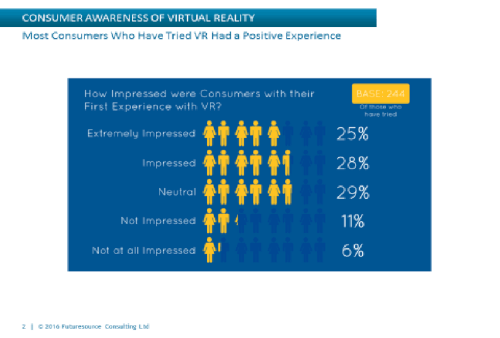Futuresource Consulting has announced the publication of its new Virtual Reality (VR) Report titled ‘Virtual Reality – Niche or Mass Market?’ This review provides unique user and consumer insight data, as well as presenting a kaleidoscopic view of the barriers, drivers and ecosystems that should be considered when evaluating investment in this market place and understanding what key factors will take this technology from niche to mass market.
The report examines the potential of the technology across a wide spectrum of applications, including the worlds of consumer electronics, broadcast, education and B2B verticals. It also blends in supporting and corresponding trends from the Futuresource ‘Living with Digital’ report, a global study of device ownership, usage and digital content consumption.
Virtual reality is still very much in the ‘innovation’ stage, but this will start to change over the coming months as a variety of major first generation headsets hit the market. Some of the world’s largest and most prominent companies like Google, Facebook, Samsung and Sony have a great deal of faith in this new technology and are already putting in place the ecosystems required to pave the way for mass market release.

“Consumer awareness is currently good for a comparatively new technology, but there is a long way to go, with the important 16-35 demographic in particular needing to be more aware. The big issue is, for all the hype, only 3% of consumers have tried VR,” commented Adam Cox, Senior Analyst, Futuresource Consulting. “This needs to be a lot higher if people are going to be persuaded to part with a significant amount of cash. They need to understand what they’re going to purchase and no amount of marketing can do that – with VR you have to try it! VR has the potential to create significant revenue opportunities across the industry and it will fail if consumers aren’t aware of the technology or don’t have the opportunity to try it.”
“Opportunities to try VR are currently rare for the average consumer. A considerable number of headsets are now available, but in order to try VR consumers have to largely rely on friends or colleagues with headsets or go to trade shows or other similar promotional events. The channel therefore has a huge role to play in educating consumers – it is the logical place for consumers to have contact with VR for the first time.
If people don’t have the opportunity to try before they buy, it will limit headset sales and risk a backlash from people who have spent a great deal of money on the strength of the hype, but are disappointed with the reality of VR,” says Cox.

The global headset market remains in its infancy, with low level sales volumes to date, although the market will be given a significant boost over the next six months. The launch of Samsung’s Gear VR consumer unit in Q4 2015 as well as the imminent launches of the Oculus Rift and HTC Vive will transform the market along with the launch of the PlayStation VR headset later in the year.
In terms of content that people are most interested in experiencing in VR, according to Futuresource research, is movies and games. They feature highest in the list, with 39% of consumers sampled interested in experiencing movies in VR while 38% were interested in gaming in VR.
Only 26% of consumers were interested in experiencing VR sports, but as with movies and games, those consumers who already have a monetary commitment to the genre (a premium movie or sports subscription or a games console) showed a much higher level of interest.
Gaming, thought by many to be one of the key drivers for consumer VR uptake, is one of the areas focused on in the report. A major contributor to this will be the continued growth of the installed base of PS4 consoles which will be key in driving demand for Sony’s own headset. In the PC gaming sector the dominance of Valve and its Steam gaming platform will fuel uptake of the HTC Vive headset, although the hype around the Oculus Rift will make it hard to beat within high-end gaming.
Futuresource Consulting predicts that total consumer VR content (video + games) will reach $8.3 billion by 2020.



